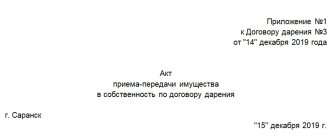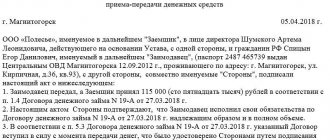For what purpose is an act of acceptance and transfer of goods drawn up?
The acceptance certificate is a document drawn up upon receipt of the purchased products by the buyer. It confirms the fact that the customer does not have any questions or complaints regarding the condition of the goods, their integrity, quantity, etc.
At the legislative level, there are no restrictions regarding persons who have the right to draw up such documents. As practice shows, the act is most often used in transactions made by legal entities and individual entrepreneurs among themselves or with buyers represented by citizens. The law does not prohibit the use of a document by individuals when concluding transactions between themselves, but this is rare.
The act must be drawn up immediately upon transfer of the goods to the customer and upon receipt of funds (if payment has not been made earlier).
IMPORTANT:
Technically, the act can be drawn up before the moment of transfer, but it will not have legal force until the signature of the recipient of the product is affixed to the document.
Shelf life
Some may think that if you can do without drawing up a document, there are no rules regarding the period of its storage. However, this is a misconception. The deadline is not defined by law. As a rule, documents of this kind must be stored in accordance with the internal rules of the enterprise. But at the same time, their shelf life must be more than five years.
The act of acceptance and transfer of project documentation is a special document that reflects the fact of acceptance/transfer of the project from one person to another, most often from the designer to the customer. The design documentation itself is a set of documents that contain information in text and graphic form that defines various solutions (structural, technological, engineering, architectural, technical) to ensure construction and restoration work, as well as major repairs of building elements (structures).
This is important to know: What documents are needed to apply for child benefits: list and procedure for registration
The transfer of the finished project must be carried out taking into account the correct preparation of the form in a form that is approved at the legislative level. Below we will consider why and to whom the papers are transferred, how this happens, and what to consider when drawing up the transfer and acceptance certificate.
How to correctly draw up a goods acceptance certificate
The act of acceptance and transfer of goods must be drawn up in at least two copies - one for each party to the contract. If there are third parties interested in the transaction, it is allowed to publish the document in three or more copies.
IMPORTANT:
It is important to compose exactly two originals. You cannot prepare one document, certify it with signatures, and then copy it on a photocopier and give it to the other party to the transaction. In this case, the document will be invalid and cannot be used as evidence confirming the fulfillment of obligations under the contract.
Form of the act
The transfer and acceptance certificate is an optional document. At the legislative level, organizations, individual entrepreneurs and citizens should not always use it when making transactions. Often, the parties make do with drawing up a regular consignment note drawn up in the TORG-12 form.
However, if the subject of the transaction is something expensive or the internal policy of one of the parties implies the use of an act, then it is drawn up.
Due to the fact that the acceptance certificate is not a mandatory document, the law does not regulate any unified form that the parties should use.
Each organization, individual entrepreneur or citizen has the right to use its own form or draw up an act in free form, subject to compliance with the rules for maintaining official documentation.
Act of acceptance and transfer of material assets
The content of the act on receipt of any material valuables should contain several sections:
| № | Chapter | What is indicated |
| 1. | Requisites | Detailed information about the parties to the transaction. |
| 2. | Information about the subject of the transaction. | Information about the transferred product, its price, quantity, total transaction cost, etc. |
| 3. | Certification of the document. | Stamps, signatures are affixed, and the date of certification of the document is entered. |
Who should sign the apartment acceptance certificate first?
The procedure for fulfilling the developer’s obligation to transfer a shared construction project is determined by the rules of the Federal Law of December 30, 2004 No. 214-FZ “On participation in shared construction of apartment buildings and other real estate and on amendments to certain legislative acts of the Russian Federation” and can be specified in a participation agreement in shared construction. Art. 6 of this law, the developer is obliged to transfer the shared construction object to the participant in shared construction no later than the period stipulated by the contract. The website discussed in some detail issues related to changing the deadline established by the contract and the procedure for such a change. See about this https://protection-shareholders.rf/help/119-0084https://protection-shareholders.rf/help/10-0017
The general procedure for transferring a shared construction project is determined by Art. 8 of the said law, according to which the transfer of a shared construction object by the developer and its acceptance by a participant in shared construction are carried out according to a transfer deed or other transfer document signed by the parties. In this case, the transfer of a shared construction project is carried out no earlier than after receiving, in accordance with the established procedure, permission to put into operation an apartment building and (or) another real estate property.
We recommend reading: What is needed to transfer a child to another kindergarten
Step-by-step guide to writing a deed
When writing an act, it is recommended to consistently follow the algorithm:
- Filling out the details section.
- Entering information about the subject of the transaction.
- Certification of the document with seals and signatures.
Information about the parties to the agreement
Information about the parties to the transaction and their details are entered in the first section. It consists of two blocks:
- "a cap";
- main text.
The header contains the following information:
- document number used for its registration in internal accounting;
- number of the agreement to which the act is an annex, and the date of its conclusion;
- date of writing the act.
The main part contains detailed information about the parties to the transaction:
- For legal entities:
- full name of the organization;
- enterprise registration form;
- Full name of the head;
- Full name and position of the person authorized to issue and sign this kind of document, as well as details of the document giving the employee the rights to certify acts of acceptance and transfer of goods;
- registration number with the Unified State Register of Legal Entities (affixed only by agreement of the parties, not required).
If the transfer of products or goods is carried out within the jurisdiction of one organization, for example, from the head office to a representative office or branch, etc., then the details must indicate the full name and other data of a specific division of the legal entity.
2. For individual entrepreneurs:
- Full name of an individual entrepreneur;
- individual entrepreneur registration number in the Unified State Register of Individual Entrepreneurs (entered if both parties need it);
- Full name and position of the person responsible for signing the act, number and name of the local document of the organization, on the basis of the publication of which the employee is vested with such powers (this can be an order, job description, separate order, extract from the charter, power of attorney certified by notarial procedure, etc.)
3. For citizens: only full name is indicated.
Conditions
The following information is sequentially entered into the conditions section:
- Details of the document confirming the fact of the transaction.
- Text reflecting the fact of transfer of goods.
- Table with information about the products being transferred.
- Total transaction value.
- Provisions on the condition of the goods (can be implemented in the form of a list from which the buyer selects items that satisfy him, or can be made in the form of empty lines that are filled in by the receiving party);
- Provision on the absence of claims to the accepted goods.
List of goods
The table with information about the products is filled out in the following diagram:
| Serial number | Name of product | Number of copies | Price per unit before value added tax. | Price per unit after VAT |
| 1. | — | — | — | — |
| 2. | — | — | — | — |
| 3. | — | — | — | — |
| Summarized indicators: | The total number of copies of all types of goods. | Total price excluding VAT. | Total cost after VAT. | |
Signatures of the parties
At the end of the document, the signatures of each interested party and the date of certification of the act are affixed. Each copy must be signed manually by the person responsible for receiving the goods. There are no additional conditions regarding the pens and ink that must be used.
IMPORTANT:
After affixing signatures and seals, the seller and the person delivering the goods (if any) are relieved of all responsibility for safety. If after this the buyer discovers defects that do not satisfy the terms of warranty service, then it will not be possible to file any claims through the court or exercise the right of free replacement or repair.
Until 2020, organizations were required to use company seals or stamps when certifying official documentation of the organization, which also applied to acts of receipt of goods. However, as of 2020, this rule has been abolished. Now, whether to use seals or not is up to the parties to the transaction to decide. If there are no mutual claims on both sides regarding their absence, then stamps do not need to be used.
Features of document preparation
The ability to use a free form for drawing up an act does not at all negate the need to adhere to a business style in drawing up such documents. The following information is required here:
- Document's name;
- Place and date of compilation;
- Name of the organization;
- Detailed description of the transferred documentation;
- Full name of the persons who sign the act.
In some situations, when particularly important documents are transferred, an appropriate commission is appointed, which confirms the fact of transfer and receipt. If such a commission exists, its composition is included in the document. Each member of the commission must put his signature here. In this case, it is in the presence of the commission that documents are directly transferred.
The recipient is advised to check which originals are provided. The act must also contain comprehensive information about this.
One might say that this is in the interests of the sender. For example, if the recipient loses some important financial document, he may say that he simply did not receive it.
With the help of the act, the person transferring the documentation will be able to prove that he is right.
As a rule, the receiving party is responsible for checking the documents. If a commission is involved in the transaction, this responsibility usually falls on its members. If the transfer occurs within the same company, the deed is signed by its director.
The act can be filled out manually or using a computer type. After printing the completed document, you must put a “live” signature on it.
This is important to know: Registration of returning goods to the supplier: list of documents in 2020, new rules
There is no urgent need for stamps. However, if the parties have such a desire, no one forbids doing so.
In some situations, when documents of high value are transferred, an annex to the act is drawn up. This is usually done by agreement of the parties.
This application is a separate document, which describes in detail all transferred documents.
Form for acceptance and transfer of goods (download)
There is no universal form for drawing up the act. Organizations use independently developed samples or draw up a document in free form. Therefore, finding a universal form that would satisfy the requirements of all enterprises is not possible.
Sample form:
.
Regardless of the external design of the form and the layout of the form used, when entering information you must follow the following rules:
- corrections, errors, typos in the content and other shortcomings may lead to the fact that the document becomes invalid from a legal point of view, and it cannot be used as evidence of completion of the transaction - errors and omissions are unacceptable;
- all details of the parties must be entered exactly as they are indicated in the passport - for citizens, in the Unified State Register of Legal Entities - for individual enterprises, in the Unified State Register of Legal Entities - for organizations;
- All information that is filled out directly during the procedure for transferring goods must be entered in writing; these lines cannot be printed in advance.
How long do you need to keep the document?
The certificate of acceptance and transfer of goods should be kept for at least four years. Moreover, the countdown begins from the moment when the tax period in which the transaction was completed ends. That is, if the purchase of something by an organization was made in July 2020, then the countdown of four years will begin on January 1. 2021, accordingly, the act will need to be stored until January 1. 2025
This requirement is regulated in paragraphs. 8 of the first paragraph of Art. 23 of the Tax Code of the Russian Federation dated July 31, 1998, as last amended on July 20, 2020. The provision applies to all documents that are necessary for maintaining tax records. An act of acceptance of goods is such.
Common mistakes on the topic
Error: The opinion that the act of acceptance of goods is a replacement for a contract or invoice.
The act of acceptance and transfer of products is an additional document. It is used in situations where the recipient needs additional guarantee that the goods he purchased will be delivered intact in full, or when the seller requires accurate reporting. The act cannot replace the contract on the basis of which the transaction takes place and the invoice describing all goods at the time of their dispatch.
Sample
The transfer and acceptance certificate is drawn up according to the following rules:
- The title of the document is written at the top.
- The year is indicated on the upper left side, and the day and month on the right.
- The following is the name of the executing company (full name, position), as well as the basis on which it acts (power of attorney, regulations, charter). It is also indicated here that the second party is the customer. An agreement is drawn up between the parties, according to which:
- The contractor submits and the customer accepts the work.
- The project was completed in full and within the terms established by the contract, taking into account the conditions specified in the agreement and the design assignment.
- The price of work to complete the project (written in numbers and in words).
- No claims to the designer regarding the content of the project.
- Drawing up the act in two (three) copies (depending on the number of parties).
- Signatures.
Contractual relationships are quite common. Any provision of services is based on the conclusion of an agreement.
He is the guarantor that each party will fulfill its obligations towards the other party. As a rule, one of the parties acts as a customer, the second is a contractor.
The legislation of the Russian Federation puts forward certain requirements for the preparation of documentation and the conclusion of such transactions. If these requirements are not met, in the event of litigation, it is quite easy to declare the agreement invalid and challenge it in court.
This is important to know: Indexation of pensions in 2020: table
One of the mandatory conditions for concluding transactions and preparing documentation is the act of acceptance of the transfer of completed work. It is needed in order to record the fact that the work has been completed, and also indicates that the customer is fully satisfied with the quality of goods and services.
Answers to frequently asked questions
Question: How long should an individual keep a deed?
Answer: Drawing up acts between citizens is a rather rare practice. However, the rules regarding shelf life are the same for everyone, regardless of status. The certificate must be kept for at least 4 years.
Question: Is it possible to find the form for the act online?
Answer: Yes, you can. However, it should be understood that there is no unified form for drawing up an act of acceptance of goods. Therefore, when downloading any sample from the Internet, before using it, you need to make sure that the document is correct, that all necessary sections are present, and, if necessary, make adjustments.







